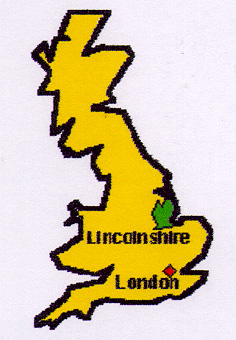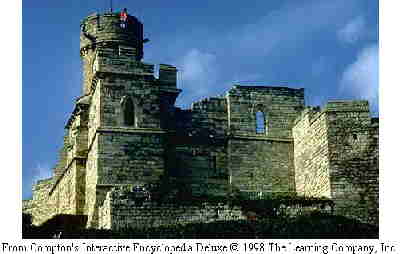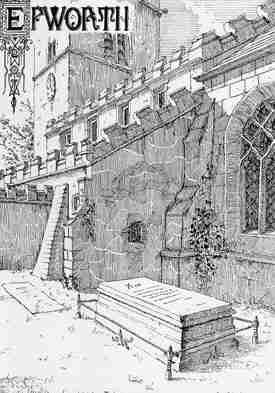
Our family's earliest "known" ancestor in England is John Bramhill and his wife Elizabeth dating to about 1700. We now have contact with a cousin in Epworth, Mrs. Annie Bramhill Cundall whose Great Grandfather Matthew Bramhill is George Bramhill’s father. George Bramhill (b. 1818) and Ann Garland emigrated from Lincolnshire, England around 1854 and settled in Palmerston Ontario Canada.
Lincolnshire
Lincolnshire County is located on the eastern side of
England, 100 miles (160 kilometers) north of London. Lincolnshire is a
spacious and diverse county located on a fertile floodplain below sea level.

The area was first colonised by groups of Stone Age hunters who roamed its virgin forests and camped on its uplands. As farming followed hunting, the great fertility of the soil attracted a growing community of pioneers, and rural Lincolnshire was born. Throughout the ages the lure of good farming land and the nearness to trade routes brought successive groups of invaders and settlers: Romans, Saxons, Vikings and Normans, all have left their mark on Lincolnshire County today.
In Roman times this area was called "Lindum Colonia" for the Roman colony established in the late first century AD. Over time Lindum Colonia was shortened to Lincoln.
Medieval Lincolnshire was one of the richest and most
densely populated counties in the land. Today the traces of deserted villages
and the lonely ruins of once lofty abbeys still bear testament to those
busy and prosperous times. Great houses, mud and stud cottages, railway
stations – each age of Lincolnshire's history has stamped its mark on town
and countryside creating a landscape rich in heritage.
Epworth, England, small town located in Lincolnshire, notable as the birthplace of John Wesley, the founder of Methodism.

Lincoln Castle, dating from the 11th century, stands on
the steep slope called the Lincoln Edge in Lincolnshire, England.
WESLEY, John (1703-91) In the early part of the 18th century in Oxford, England, there gathered around John Wesley, a young clergyman, and his brother Charles, a student at Christ Church, a group of young men that came to be known as the Holy Club. Their strict lives and methodical ways led other students derisively to call them Methodists. Thus the denomination that Wesley founded got its name.
 John
Wesley was born in Epworth, Lincolnshire, where his father was the
rector of a Church of England parish. (The picture to the right is of Sam
Wesley’s grave at his parish in Epworth.) He was educated at Oxford, became
a deacon in the church in 1725, and two years later became his father's
curate, or assistant. In 1735, with his brother Charles, he went to America
as a missionary to Georgia. During the stormy voyage he was deeply impressed
by the calm faith of some fellow passengers, a group of Moravians from
Austria. He studied their doctrine and, while attending a Moravian meeting
in London after he returned, felt his heart "strangely warmed" with faith
in the saving power of Christ. He began preaching his new faith.
John
Wesley was born in Epworth, Lincolnshire, where his father was the
rector of a Church of England parish. (The picture to the right is of Sam
Wesley’s grave at his parish in Epworth.) He was educated at Oxford, became
a deacon in the church in 1725, and two years later became his father's
curate, or assistant. In 1735, with his brother Charles, he went to America
as a missionary to Georgia. During the stormy voyage he was deeply impressed
by the calm faith of some fellow passengers, a group of Moravians from
Austria. He studied their doctrine and, while attending a Moravian meeting
in London after he returned, felt his heart "strangely warmed" with faith
in the saving power of Christ. He began preaching his new faith.
When he found the churches closed against him, he joined the celebrated evangelist George Whitefield in holding open-air meetings.
Wesley's energy was amazing. He traveled about 5,000 miles (8,000 kilometers) a year and preached about 15 sermons a week. In spite of opposition and persecution, thousands attended the meetings, and the movement spread rapidly. Wesley organized his converts into bands for prayer and church societies, appointed leaders to act as lay pastors, and finally ordained or commissioned preachers. These actions amounted to a break with the Church of England, though Wesley himself did not recognize it as such. He died in London on March 2, 1791.
Charles Wesley (1707-88), who was associated with his brother John in religious work, is best known as a hymn writer. He published more than 4,500 hymns and left about 3,000 in manuscript.
Another notable historical figure was Henry IV (born 1366, ruled 1399-1413). Henry of Bolingbroke, alternately known as Henry of Lancaster, was born at Bolingbroke Castle in Lincolnshire, probably in April 1366.
Henry IV was the son of John of Gaunt, duke of Lancaster, and the grandson of King Edward III. He was the founder of the Lancastrian line of English kings. These kings were later to dispute the right to the throne with the York line, also descended from Edward III, in the Wars of the Roses (see Roses, Wars of the).
In his youth Henry was distinguished for his prowess in knightly combats. Between 1390 and 1393 he joined the Teutonic Knights in Lithuania and in Prussia. He also visited the Holy Land. In 1398 Richard II banished him from the kingdom (see Richard, Kings of England). When John of Gaunt died the following year, Henry returned to England to claim his father's estates, which Richard had confiscated. With the support of Henry Percy, earl of Northumberland; Percy's son, known as Harry Hotspur; and Ralph Neville, earl of Westmoreland, Henry raised an army and forced the abdication of Richard. Parliament declared him the lawful king.
Henry suppressed an uprising in Wales under Owen Glendower and a revolt in Scotland. There were disputes over his right to the throne, and later the Percys and Neville conspired against him. At Shrewsbury in 1403 they were defeated and Hotspur was killed. Henry died in Westminster Abbey on March 20, 1413, after a five-year illness. His eldest son, Henry V, succeeded him.
- End -